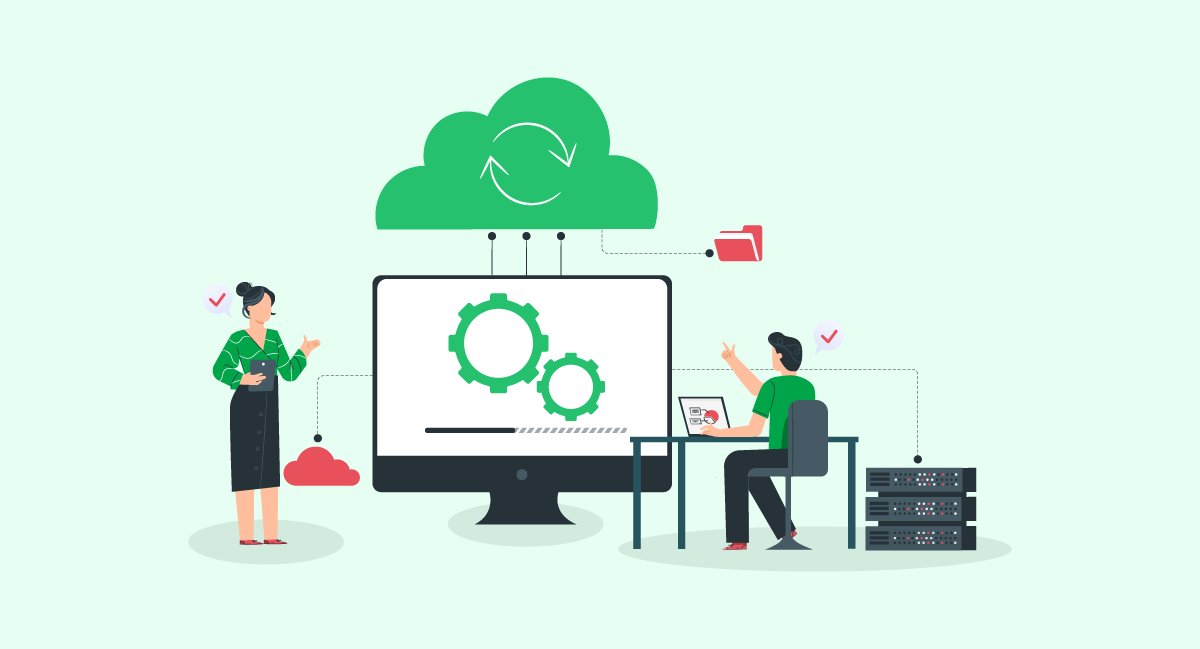Reading Time: 7 Minutes
Published : July 15, 2022
Last Updated: July 15, 2022
The present times are rightly called the ‘digital era’ since everything we do has a software element to it. Humans today use software not only for work but also to unwind, share laughs and manage our personal lives. Hence it would be correct to say that we are in the middle of a software revolution.
At the center of every revolution lies a problem, barrier, or discomfort that fuels it and makes it necessary. For instance, the numerous software applications that we use simultaneously have to be downloaded and stored on our computers to be accessed, affecting the speed of operations and impacting storage and setup costs.
This was the reason behind the creation of SaaS (Software-as-a-Service) platforms.
The Rapid Emergence of SaaS
SaaS platforms require no downloads or storage and can be accessed via the internet instantly. They usually have a subscription-based model and need no updates or maintenance. As a result, most businesses use an array of SaaS applications today.
However, with so many SaaS applications running side-by-side, companies also require a SaaS Management Platform to keep track of their applications and manage subscriptions and permissions.
Let us now look at some of the biggest mass movements in history that have shaped the society that we live in today:
1. The Industrial Revolution
The industrial revolution completely changed the course of human history, improving the quality of our lives and reducing workload considerably. Before the revolution began, every single task was done manually, and companies were heavily dependent on workers.
The emergence of machines allowed companies to reduce their dependence on manual labor, and all major industries shifted to machinery.

Source: Unsplash
With machines becoming more and more common, all aspects of living were influenced heavily. While companies benefited from bulk production, the quality of life for workers improved as well. Additionally, bulk production reduced the costs of most products, making them affordable for the masses.
With the introduction of machines, every aspect of living was influenced. People benefited from bulk production in the factory. They were able to access products that were expensive earlier.
Reasons behind the Industrial Revolution: The industrial revolution happened when labor discontent was at its peak. Workers had 12-hour shifts and were hardly provided with any amenities. Organizations had a tough time boosting their productivity, and the cost of labor was increasing rapidly.
Hence firms had to choose between oppressing their workers or losing their production value.

Source: Zluri
Machines made the production process faster, cheaper, and more accurate. There was a much lesser margin for errors, and unlike humans, they required no prior training before starting work.
Additionally, machines required no breaks like human labor and could do the work of many workers in less time. The cost of a machine was much less compared to hiring and training a bunch of workers, and the output was much higher too.
2. The Computing Revolution
The computing revolution began when Personal Computers (PCs) became available to the public in the early 1980s. Before this time, the only type of computer available was mainframe computers, and they too were available to governments, scientists, cryptanalysts, and large corporations.
They were also massive in size, thanks to vacuum tubes, and very expensive.

Source: TheConversation
Anyone could operate personal computers without much training, and using the power of the internet, they have helped humans achieve great feats. Today, such computers have evolved into desktops, laptops, tablets, and smartphones, becoming a vital part of our lives and livelihoods.
Be it in education, communication, transport, financial operations, or marketing, PCs have numerous applications. As such, they help ordinary individuals achieve extraordinary feats effortlessly and allow them to access a world of information.
Reasons behind the computing revolution: The proliferation of PCs was primarily caused by the availability of computing power. By replacing vacuum tubes with transistors, computing soon became much faster, cheaper, and a whole lot better.
Vacuum tubes made mainframe computers bulky, costly, and unreliable. Additionally, such computers required extensive training and expertise to be operated, and due to the heat dissipated, they were error-prone. They also needed a huge amount of electricity to be operated.

Personal computers (PCs) were far better than mainframe computers. They were easier to learn and operate. Their processing unit was made of transistors, making PCs much faster and more accurate than mainframes.
Additionally, personal computers had much more data storage space than their mainframe counterparts, making them very popular.
3. The Information (IT) Revolution
The information revolution allowed us to transform how we communicate and receive information rapidly. While people relied on newspapers, television, and radio for information in the past, the advent of the internet allowed them to access data (and share it) instantly.
The internet allowed people to communicate with each other and share their views freely. Thus, instead of being forced to listen to a handful of people, all individuals could share their beliefs freely.
The internet has surely been a boon to learners and has helped many corporates with remote working as well.

Source: LinkedIn
The internet enables people to collaborate from thousands of miles away. It also allows millions of people to search for information instantly, make cashless payments, and stay connected through social media. In fact, without the internet, our civilization would have come to a standstill during the recent pandemic.
What caused the information revolution?
The primary impetus behind the information revolution is the internet. The internet has made information sending and retrievals much faster and cheaper. It requires much less effort compared to the older ways of information searching. Also, any information can be searched from anywhere and at any time.

The internet also reshaped our communication preferences, making letters obsolete. Additionally, it has made online transactions and multimedia sharing effortless and instantaneous with technologies like 4G and 5G.
4. Software Revolution: The Emergence
As seen from the examples above, the common thread that binds these revolutions is convenience and things becoming faster and cheaper. The software revolution also began when the masses started using software on a daily basis.
This was caused after the launch of the SaaS delivery model, which helped users avert massive setup costs for on-premise software.

Source: Inc Mag
The SaaS model saved users much of the time that would be spent setting up a software on their premises. Additionally, SaaS solutions provided free trials, meaning that users could test out a software before choosing to continue with them, preventing vendor lock-ins.
Today, there are multiple SaaS applications available for each use case. Thus, users can choose between numerous applications and pricing plans that match their needs. SaaS solutions are very easy to procure, and most of them offer free trials.
However, organizations that deal with multiple SaaS applications simultaneously require SaaS management software to keep track of their SaaS expenditure and permissions.

The Software Revolution: Trends & Predictions
The software revolution that we are experiencing today has various implications for the future, which are listed below:
1. Consumerization of Software
With the evolution of technology, machines can now interact with each other and make autonomous decisions based on how they are configured. Additionally, more and more SaaS applications are being designed for small enterprises.
Similarly, there are thousands of apps being launched each day for end-users, bringing the dawn of software consumerism, where humans will be heavily dependent on software. Due to the sheer number of SaaS applications being used in each organization, a SaaS management platform is slowly becoming a necessity.
2. Need for software governance
As software adoption becomes cheaper and more effortless, most organizations are expected to have a clogged SaaS ecosystem with redundant/duplicate apps, unused licenses, and unaccounted subscription plans. This often results in shadow IT, which makes your firm susceptible to security, compliance, and financial risks.
SaaS management software is now used extensively throughout organizations to
prevent ‘shadow IT,’ manage expenses and avert data threats.
A SaaS management platform offers insights into organizational SaaS usage, permission overlaps, expenses, duplicate apps, etc. Such applications offer real-time notifications and insights, automate IT tasks, and also help companies with safe employee offboarding.
3. The 100% Software Era
Many experts believe that we will soon experience a time when everything will be done using software. SaaS management software will become more advanced, and there will be software to do most of the human tasks, and it can happen anywhere between the next 5-10 years.
Conclusion
The software revolution is imminent, and human dependency on software is expected to proliferate in the coming years. Hence, SaaS management software will become a very useful tool for organizations in the future and will have more advanced features for security, visibility, and cost control.
Subscription-based pricing will likely become the de-facto software pricing model in the next few decades.
[adsanity_group align=’alignnone’ num_ads=1 num_columns=1 group_ids=’15192′]
Need Any Technology Assistance? Call Pursho @ 0731-6725516




